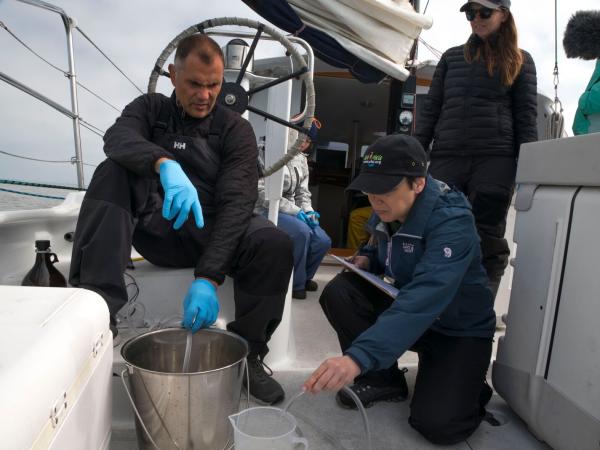Design and Communications
Our Team in the Design and Communications
The San Francisco Estuary Institute comprises over sixty scientists, technologists, and designers who offer a wide range of expertise. Each team member, in her or his own way, helps to define environmental problems, advance public debate about them through sound science, and support consensus-based solutions that improve environmental planning, management, and policy development.
Projects Related to the Design and Communications
 The Pulse of the Bay
The Pulse of the Bay
https://www.sfei.org/documents/2019-pulse-bay-pollutant-pathwaysDownload the Pulse of the Bay! This report from the Regional Monitoring Program for Water Quality in San Francisco Bay features articles on the four major pathways by which pollutants enter the Bay: municipal wastewater, industrial wastewater, stormwater, and dredging and dredged sediment disposal. Each article provides a basic introduction to the pathway and discusses the regulatory framework, recent findings, and future challenges. The report also includes some of the latest highlights from monitoring of important parameters such as nutrients, emerging contaminants, mercury, PCBs, and selenium.
 RMP Update
RMP Update
The Regional Monitoring Program for Water Quality in San Francisco Bay is an innovative collaboration of the San Francisco Bay Regional Water Quality Control Board, the regulated discharger community, and the San Francisco Estuary Institute. It provides water quality regulators with the information they need to manage the Bay effectively. The RMP produces two types of summary reports: The Pulse of the Bay and the RMP Update. The Pulse focuses on Bay water quality and summarizes information from all sources.
 Re-Oaking
Re-Oaking
“Re-Oaking” is an approach to reintegrating oaks and other native trees within the developed California landscape to provide a range of ecosystem services. The concept has emerged from SFEI's research into the distribution and characteristics of California's former valley oak savannas -- a distinctive, widespread habitat that was mostly lost a century ago. Now valley oaks and other native trees are being recognized for the benefits they did -- and could again – provide, as communities design the ecologically healthy and resilient landscapes of the future.
 Perfluoroalkyl and Polyfluoroalkyl Substances (PFAS)
Perfluoroalkyl and Polyfluoroalkyl Substances (PFAS)
A recent analysis of PFAS in the surface waters of SF Bay was conducted to understand the occurrence, fate, and potential risks to ecological and human health. Eleven of 40 PFAS were detected at part per trillions (ppt) concentrations in ambient water collected in 2021 from 22 sites in the Bay. Seven PFAS (PFPeA, PFHxA, PFHpA, PFOA, PFBS, PFHxS, and PFOS), were found in at least 50% of samples. Concentrations of PFAS in the Bay were generally consistent with similar studies globally for surface water. Sustained, multi-matrix monitoring of this important class of contaminants of emerging concern is a high priority for the RMP.
 Microplastic Pollution in San Francisco Bay
Microplastic Pollution in San Francisco Bay
Plastic pollution is gaining global recognition as a threat to the resilience and productivity of ocean ecosystems. However, we are only just beginning to understand the scope and impacts of microplastic particles (less than 5 mm) on coastal and ocean resources, and the San Francisco Bay Area is no exception. A preliminary study of nine water sites in San Francisco Bay, published in 2016, showed greater levels of microplastics than the Great Lakes or Chesapeake Bay.
 San Francisco Bay Shore Inventory
San Francisco Bay Shore Inventory
SFEI is developing an online interactive map to support regional planning and assessment given accelerated sea level rise around the Bay.
 San Francisco Bay Shoreline Adaptation Atlas: Working with Nature to Plan for Sea Level Rise
San Francisco Bay Shoreline Adaptation Atlas: Working with Nature to Plan for Sea Level Rise
In partnership with SPUR, The Operational Landscape Units project, funded by the SF Bay Regional Water Quality Control Board, will create a new way of looking at the Bay.
 Delta Landscapes Project
Delta Landscapes Project
The Delta Landscapes Project, which began in 2012 and will run through 2016, has developed a body of work to inform landscape-scale restoration of the Sacramento-San Joaquin Delta ecosystem.
 Carlos Street Rain Garden Interpretative Sign
Carlos Street Rain Garden Interpretative Sign
The Carlos Street rain garden in Moss Beach collects and filters stormwater from the street, Post Office parking lot, and adjacent private properties and businesses. By placing small rain gardens in strategic locations, pollution going to local water bodies is reduced, resulting in improved water quality in the Fitzgerald Marine Reserve and designated Area of Special Biological Significance.
Publications related to the Design and Communications
The Institute has collectively produced more than 1300 reports, articles, and other publications over the course of its 24-year existence. The following list represents those publications associated with this individual program and its focus areas.
Nothing found
Year of Publication: 2024
Year of Publication: 2022
. 2022 Pulse of the Bay. Richmond, California: San Francisco Estuary Institute; 2022 . Report No.: 1095.  (5.57 MB)
(5.57 MB) (63.26 MB)
(63.26 MB)
Year of Publication: 2021
. OPC Coastal Wetlands, Beaches and Watersheds Inventory Factsheet. March 2021th ed. 2021.  (4.3 MB)
(4.3 MB)
Year of Publication: 2018
. SediMatch Factsheet. 2018.  (1.89 MB)
(1.89 MB)
Year of Publication: 2017
Year of Publication: 2016
Year of Publication: 2015
. Carlos Street Rain Garden Interpretative Sign. 2015.  (4.35 MB)
(4.35 MB)





